Description of the Greham Thomas rose, planting and care, pruning and reproduction
Rose is the favorite flower of millions of people, there are more than three thousand varieties of roses. Roses of English varieties are especially splendid and therefore I would like to consider in detail the features of growing the Graham Thomas rose variety.
The history of the rose Graham
This variety appeared in England in 1983 thanks to the efforts of the famous breeder David Austin, who crossed two incredible varieties of roses - Iceberg and Charles Austin. Graham Thomas was a close friend and colleague of Austin, and a new plant variety got its name in his honor. For the first time this flower was presented at an exhibition in Chelsea, at that time the English rose Graham gained a clear varietal leadership among the already known types of roses.
The main features and disadvantages of culture
A distinctive feature of this variety can rightfully be called chic terry buds, which have an incomparable delicate fruity aroma, which is especially intense in cloudy weather. The color saturation of the buds, as well as the height of the bush, depends on the climatic conditions of the rose.
With proper care, the gardener will admire the wildly blooming rose almost all summer. It should be noted that the plant has good immunity to diseases and is rarely affected by pests.
Another advantage of the Graham Thomas variety is that the shrub feels great and blooms magnificently in partial shade, unlike many other varieties of roses.

There are not many disadvantages of this plant. The main disadvantage of this variety is the monotony of the color scheme, but this does not prevent it from being in demand among professionals and amateur flower growers. Also, this plant variety is widely used in the landscape design of city parks and squares.
general information
Graham Thomas rose bushes are an incomparable decoration for any garden or front garden. They are very unpretentious, but this feature does not relieve the grower of responsibility for the correct and high-quality care of the plant.
External description of the bush
- The branchy bush occupies an area of about a meter, and the plant rises up to 5 meters in height.
- Its inflorescences consist of 8 yellow flowers, each of which reaches 8-10 cm in diameter and has about 80 delicate petals that protect the center of the bud.
- The leaves of the plant have a rich dark green color.
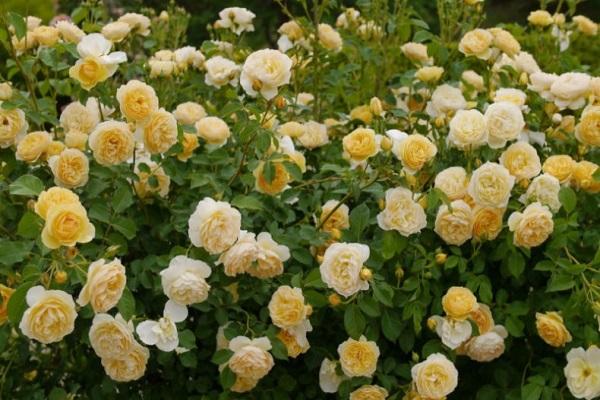
Budding and flowering
With proper care, the Graham Thomas rose blooms continuously throughout the season. Its buds of various yellow shades open one after another, constantly maintaining the splendor of the inflorescences. Due to the fact that the flowers often fade in the bright sun, sometimes it seems that the bush is filled with buds of different colors. They exude a very delicate, sweet, aroma with fruity notes.
Growing conditions of the variety
Illumination and location
Graham Thomas grows well enough in areas exposed to the sun and partial shade zones of the garden. However, in any case, the plant needs to stay in the open sun for at least 6 hours a day, so when choosing a planting site, this feature should not be ignored.
Separately, I would like to note that the seat should be well ventilated. In a well-lit area, the bush will not grow tall, but it will bloom profusely. A tall plant with rare and small flowers will grow in a shady place.

Temperature and humidity
A temperate climate is perfect for this rose variety. She feels great at a temperature of 26-28 degrees and survives the winter cold quite well, so the Graham Thomas rose variety is considered less whimsical to the temperature regime, unlike many other varieties of roses.
However, the rose has very serious requirements for soil moisture. Like all roses, this variety is very difficult to tolerate drought, so the slightest oversight in this area can cost the grower the loss of the plant. It is necessary to water the bush sparingly, as the soil dries, but it is also worth remembering that the plant is susceptible to fungal diseases, which may appear due to waterlogging of the soil.
Therefore, excess moisture can destroy the rose as well as drought.
Drafts and frosts
Drafts do not like, perhaps, more than one garden plant. And the rose is no exception. She needs a ventilated place, but protected from gusts of strong winds. The plant survives frosts quite easily, provided that the root area of the bush is previously covered.
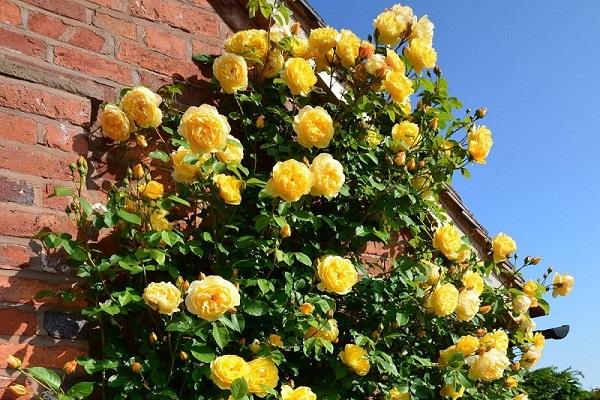
Required soil composition
Unlike some other growing conditions, the soil for the Graham Thomas rose has one of the most important values. It requires a light, fertile soil that is permeable to moisture and air. You can fertilize unsuitable soil with humus, peat, compost and sand.
The acidity level of the soil is also important. Rose loves slightly acidic soil. In order to create the required level of acidity, manure and peat can be added, and in case of excess acid, it is worth adding chalk, limestone and ash.
Preparation and planting of seedlings
Spring is considered the optimal time for planting rose seedlings, but plants planted in autumn will take root no less successfully. In order for the seedling to survive the planting safely, it must be prepared in advance. A plant seedling must be kept in a root-forming composition for at least two days, after which it can be planted in a previously prepared hole. It is done in accordance with the 50 cm rule, which means that the depth, width and distance between the seedlings should be 50 cm.
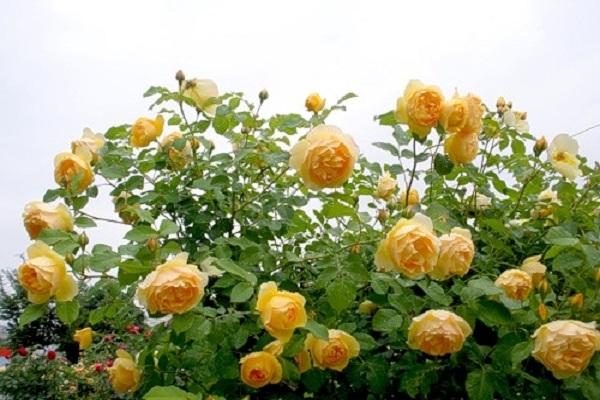
Planting holes should be well moistened, for this it is recommended to pour at least one bucket of water into each. After that, you can start planting rose seedlings. Spread the roots very carefully and lower the seedling into the hole, sprinkle it with earth just above the grafting bud and compact the soil well. Hilling and the first watering of a young bush must be done one day after planting.
Variety care
Since the Graham Thomas variety is of English origin, care for it should be carried out in a timely manner, according to the developed rules, one might say, with English pedantry. If you follow the recommendations for plant care, your rose will be a healthy, beautiful, lush bush that will delight you all summer long.
Irrigation
As you know, the rose will not tolerate waterlogging of the soil, therefore, a certain schedule for watering the plant should be worked out, based on the state of the soil around the bush. Watering the rose is necessary after the topsoil dries.
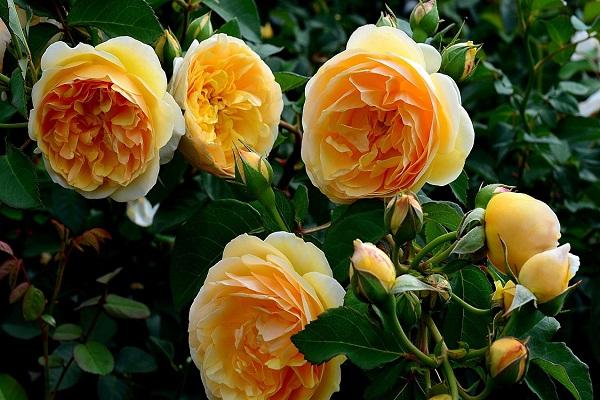
Fertilization
Always be guided by the principle "underfeeding is better than overfeeding." In order for buds to appear on young bushes, fertilizers containing calcium and phosphorus must be added to the soil..
It is recommended to do this during the active growing season of seedlings. And before the onset of cold weather, it is worth feeding the plants with potassium, this will help them to winter safely.
Pruning
The procedure for pruning a bush does not carry any functions vital for the plant. It is rather decorative. You can form a bush at will, there are no specific rules for the pruning procedure. However, do not forget to promptly remove faded buds and diseased branches in order to prevent further damage to the plant.
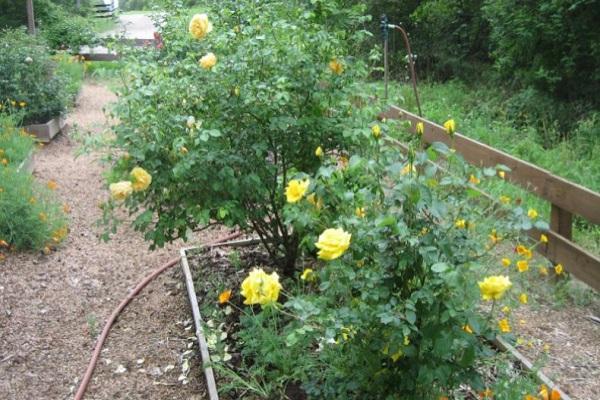
Protection against diseases and pests
As mentioned earlier, an excess of moisture in the soil leads to the disease of the Graham Thomas rose bushes with fungal infections. Among them are gray rot, powdery mildew and black spot. If you notice the symptoms of these lesions on your plants, it is urgent to remove the affected parts of the bush and treat with disinfectant solutions - Fitosporin, Gamair or Alirin. In order to prevent these troubles, it is important to have good drainage in the soil.
Among the insect pests that actively damage shrubs, spider mites, aphids and leafhoppers are distinguished. To prevent the appearance of these pests, plants can be treated with a solution of laundry soap - it is completely harmless and actively repels insects.
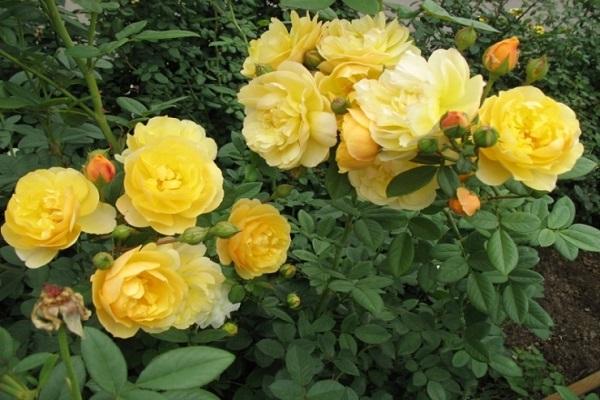
Shelter for the winter
Despite the fact that the Graham Thomas variety is considered one of the most frost-resistant, it is still worth taking care of its shelter. First you need to cut the bush short, leaving only the base with a few buds. Next, dig in the bush with sand or earth, and insulate the top with a layer of foliage or sawdust.
In the event that the climate in which the rose grows is distinguished by its severity, you can also cover the bush on top with a film or special covering material.
Breeding features
The main methods of propagation of roses are cuttings and propagation by layers. For grafting, it is important to choose strong branches with at least 3 leaves. When planting the cuttings in the ground, you must follow the planting rules given above.
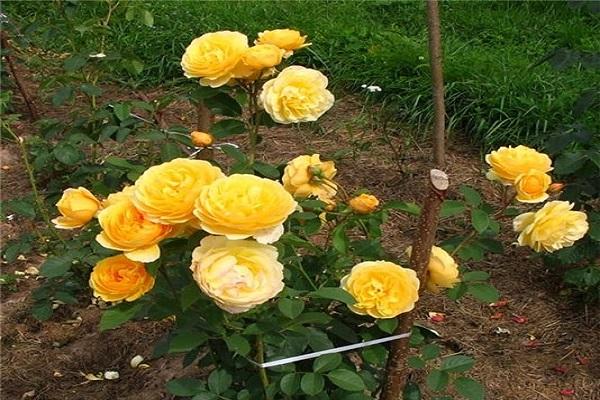
The propagation method by layering is more interesting and effective. In strong young shoots, the tip is cut off and a small stick or match is inserted. Next, the stem is attached to the ground, well dripped and watered abundantly. The best way to propagate a rose is in the middle of summer.
Variety reviews
The Graham Thomas variety is loved by gardeners in Russia and many other countries for its refinement, refinement, stamina and nobility. However, he is not very picky about growing conditions and is able to decorate any garden or park area. Even novice growers can grow a flower, it is only important to apply love and patience.
Veronica Gosteva, 32 years old, Saratov.
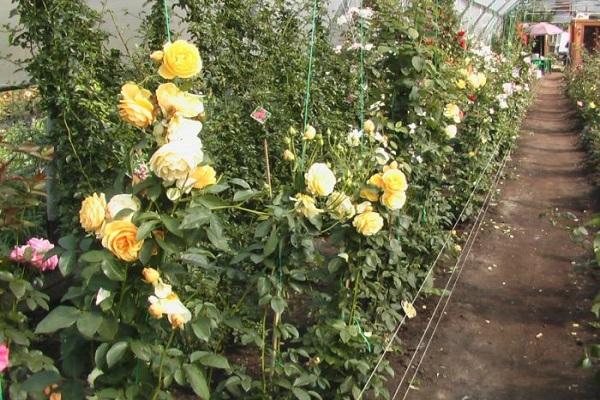
Good day! I have been breeding spray roses for 5 years. I love the Sins Thomas variety for its unpretentiousness and vigorous flowering throughout the summer season. In the first year after planting, there were difficulties in preparing the bush for winter. I overdid it with insulation and one bush sprayed under the covering material. Otherwise, no problem. This variety of spray roses only pleases with beauty!
Olga Martynova, 46 years old, Penza.
Hello! I advise everyone to plant this flower on the site! There are no problems in leaving, and there are more than enough positive emotions from its appearance!
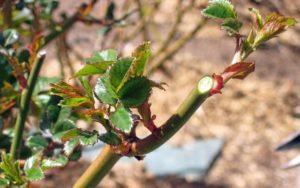







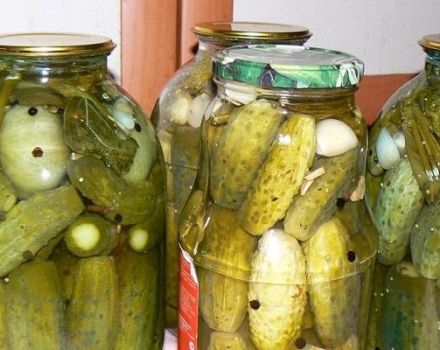

Thanks for the info!
The only thing is not clear about the match. Where, tell me, insert it?
,, The method of propagation by layering is more interesting and effective. In strong young shoots, the tip is cut off and a small stick or match is inserted. Next, the stem is attached to the ground, well dripped and watered abundantly. The best way to propagate a rose is in the middle of summer. ”
Tell us about this rose propagation method.
Thank.